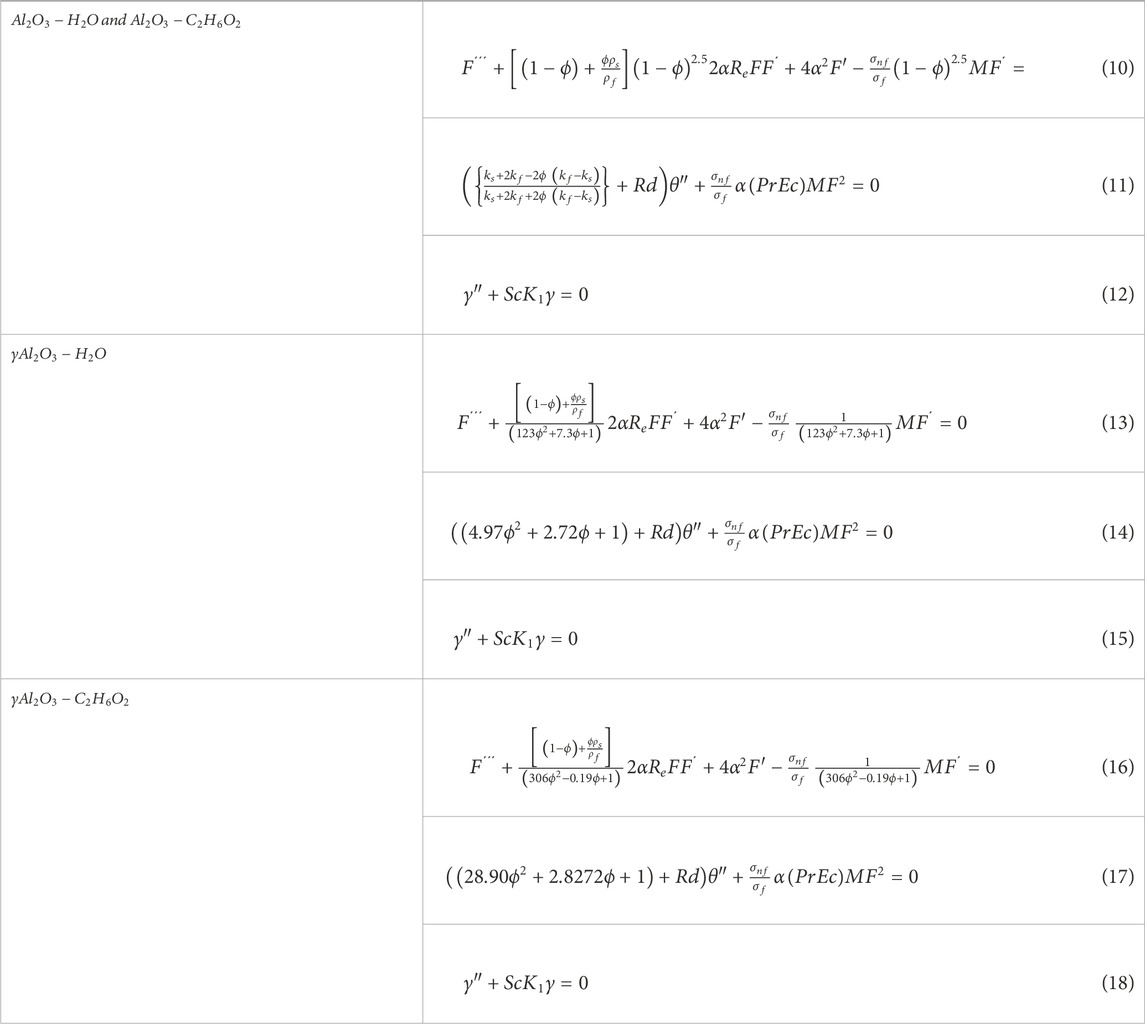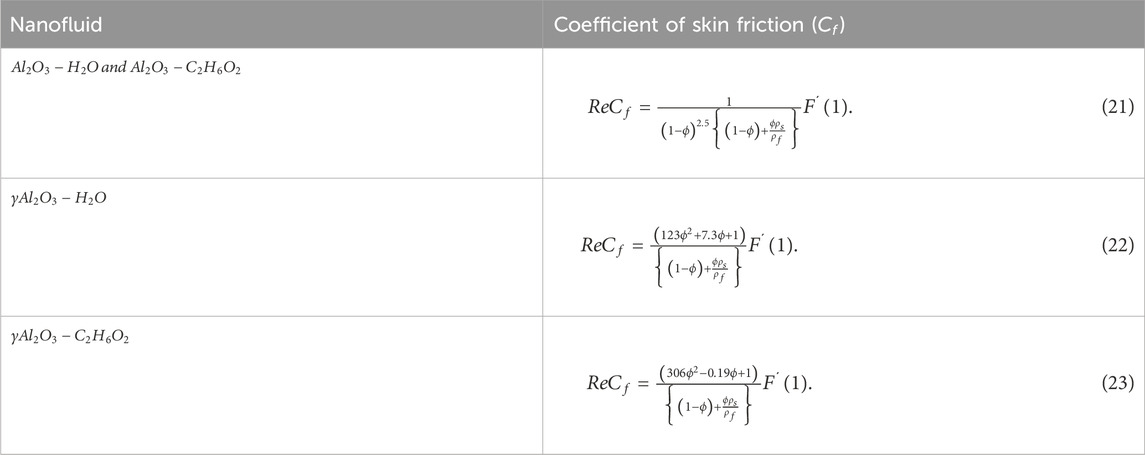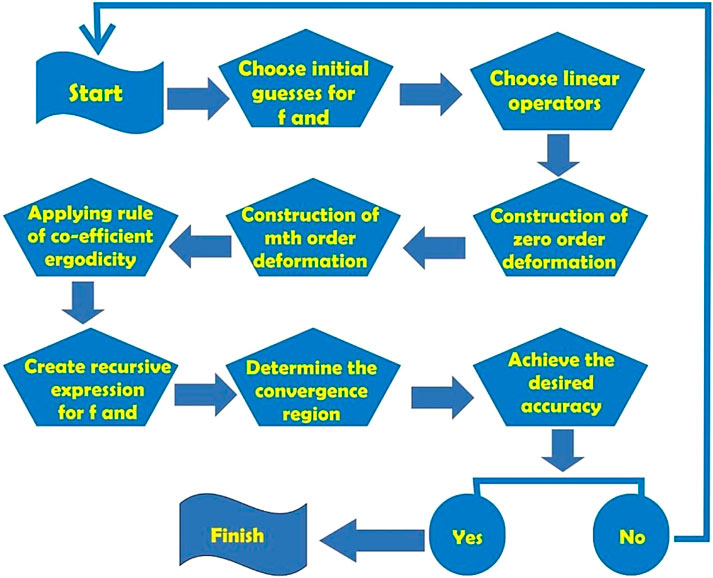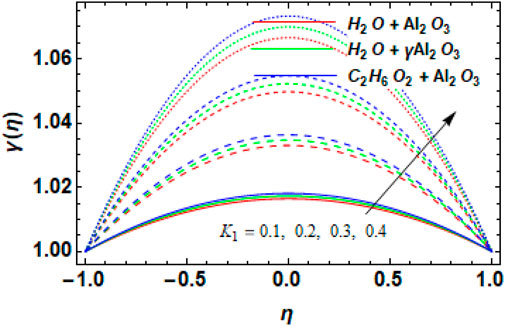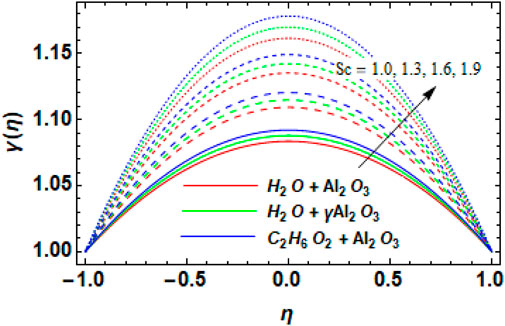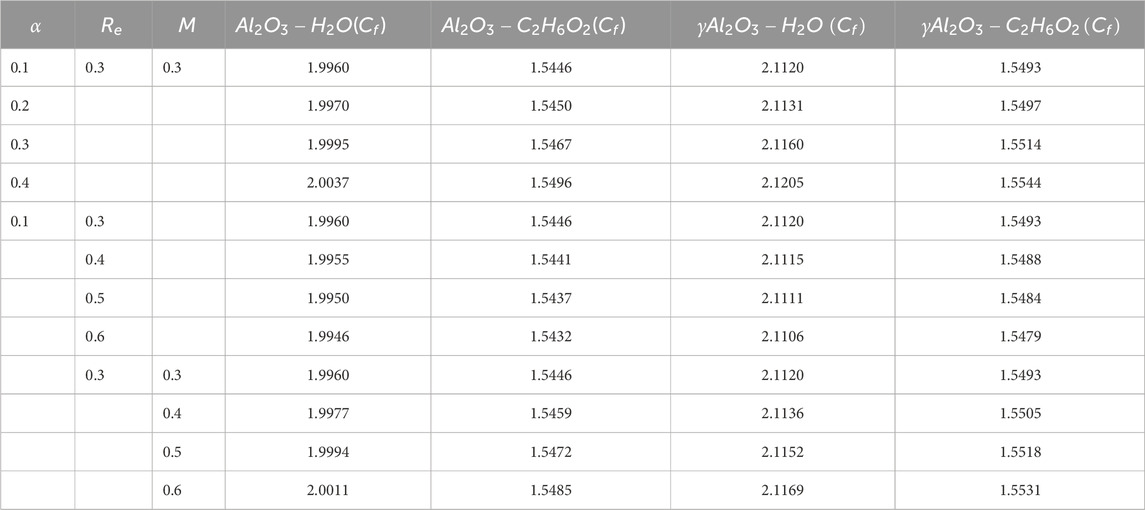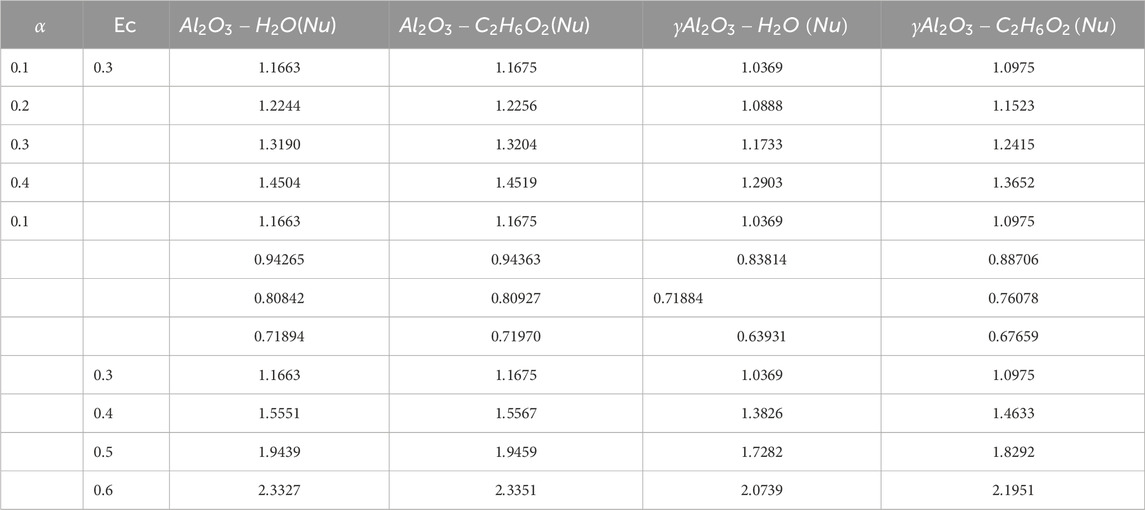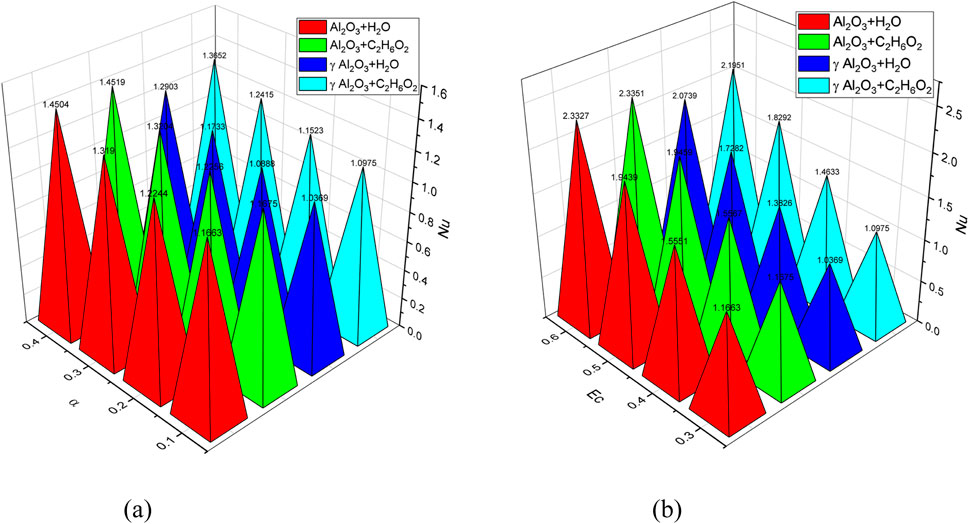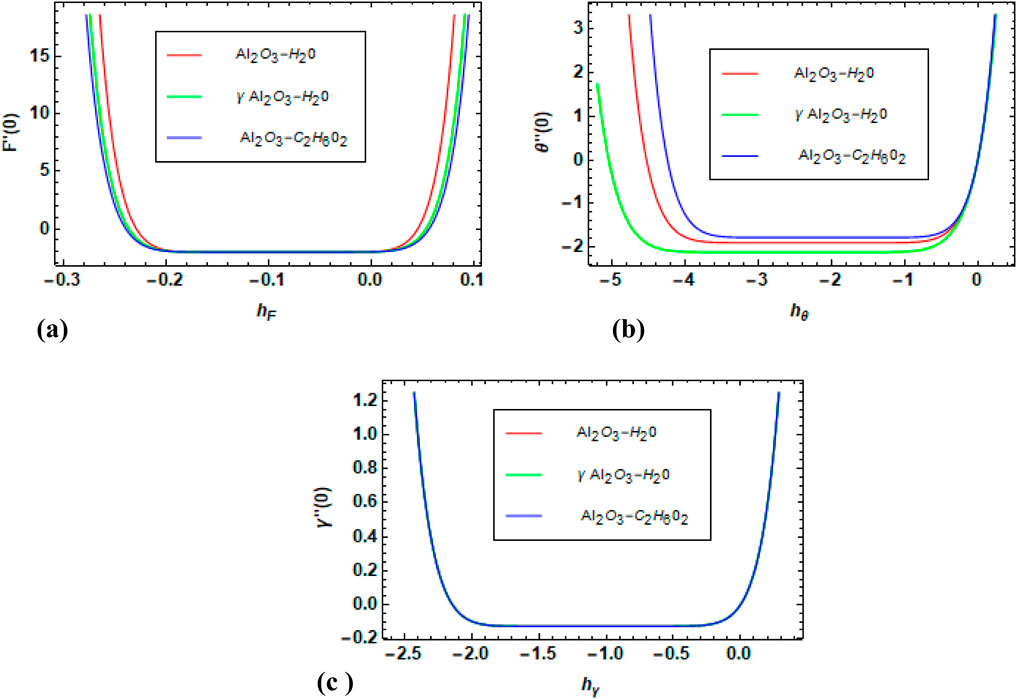- 1Department of Mathematical Sciences, University of Lakki Marwat, Lakki Marwat, Khyber Pakhtunkhwa, Pakistan
- 2Department of Mathematics, Hazara University, Mansehra, Khyber Pakhtunkhwa, Pakistan
- 3Department of Mathematics, College of Science, King Saud University, Riyadh, Saudi Arabia
- 4Department of Industrial Machines and Equipments, Faculty of Engineering, “Lucian Blaga” University of Sibiu, Sibiu, Romania
- 5Preclinical Department Faculty of Medicine, Lucian Blaga University of Sibiu, Sibiu, Romania
The study of how energy undergoes changes in physio-chemical interactions involving Al2O3 and γ-Al2O3 with water and C2H6O2 within converging and diverging channels is of great significance, given its potential applications in today’s advanced technology. We have used two types of oxide nanoparticles, namely, Al2O3 and γ- Al2O3, with water and C2H6O2. The purpose of this study is to investigate an innovative comparative magnetohydrodynamic (MHD) nanofluid flow and heat transport with the impact of thermal radiation on water and ethylene glycol (EG) suspended with Al2O3 and γ-Al2O3 nanoparticles. A novel comparison of concentration of Al2O3–H2O, γ-Al2O3–H2O, and γ Al2O3–C2H6O2 nanofluids is investigated under the influence of chemical reactions. The system of nonlinear ordinary differential equations was obtained via a similarity transformation and then solved using the homotopy analysis method (HAM) in Mathematica. The temperature and velocity profiles are obtained numerically for a range of controlling parameter values, including the volume percentage
1 Introduction
In the realm of thermo science and thermal engineering, substantial advancements have been made in the pursuit of enhancing heat transfer. One notable approach involves the incorporation of additives into liquids. This strategy becomes particularly relevant when the inherent characteristics of the flowing fluids themselves pose constraints on the efficiency of heat transfer. To address this, solid additives are introduced into the base liquids, effectively modifying the properties of transport, dynamics of flow, and thermal transmission characteristics of these fluids (Zimparov, 2002). In addition to detailing the historical progression within this particular field, Hetsroni and Rozenblit (1994) conducted a study focusing on the thermal interplay between a turbulent flow containing particles and a heated plate. Their research centered on a liquid–solid blend comprising water and polystyrene particles.
Nanofluids, which consist of colloidal suspensions of nanoscale particles distributed steadily and intermittently into traditional fluids, were developed as a solution to the primary issue of heat transfer augmentation. This newly created category is known as nanofluids. The efficiency of energy transport in nanofluids is influenced by both the characteristics and size of the nanoscale particles, along with the volume percentage of solids. Several experimental studies have highlighted that nanofluids exhibit significantly higher thermal conductivity than conventional pure fluids (Wang et al., 1999; Lee et al., 1999; Xuan and Li, 2003). These findings suggest that nanofluids hold substantial potential for enhancing heat transfer processes. In contrast to traditional methods of improving heat transfer, which involve adding millimeter- or micrometer-sized particles to fluids, nanofluids are expected to be an optimal choice for practical applications. This is due to the minuscule size of the nanoparticles, which allows nanofluids to behave much like pure fluids, resulting in minimal or negligible increases in pressure drop. Choi and Eastman (1995) made an earlier contribution in this direction. Later, Eastman at el. (2001) showed that ethanol glycol-based copper nanofluid has higher thermal conductivity than pure ethanol glycol. Xuan and Li (2003) experimentally showed that Cu–water nanofluid can enhance the heat transfer process compared to pure-based liquid. The magnetohydrodynamic (MHD) fluid flow and heat transfer of hybrid nanofluid under thermal radiation were investigated by Chamkha et al. (2019), who developed a model for nanofluids that incorporates the Roseland distribution estimate, Brownian motion, and thermophoresis, expanding the understanding of these complex phenomena. Mohamed and Wahid (Abdel-wahed, 2017) investigated the effects of nonlinear thermal radiation and magnetic fields on nanofluid flow and temperature over a moving surface.
Hybrid nanofluids represent a specialized category within the broader domain of nanofluids, characterized by the deliberate blending of two or more distinct nanoparticle types into a base fluid. Nanofluids, in their general definition, encompass finely dispersed nanoparticles at the nanometer scale, entrained within a base fluid, which can be either a liquid or a gas. Notably, hybrid nanofluids derive their nomenclature from their unique composition, whereas multiple nanoparticle variants coexist within the same base fluid. The engineering of hybrid nanofluids is oriented toward imbuing them with distinctive and tailored properties, rendering them particularly suitable for a diverse array of applications. Of paramount significance among these applications are domains such as heat transfer, cooling systems, and energy generation, where the exigencies of thermal management and energy efficiency are critical. Numerous scholarly investigations have delved into the realm of hybrid nanofluids, each offering unique perspectives and findings. Notably, Hanif et al. (2020a) provided a complete entropy analysis, focusing on unsteady mixed convection in a magneto-hybrid nanofluid flowing over an inverted cone enclosed by a porous media. Khan and Rasheed (2021) investigated thermal properties in detail using silicon dioxide and molybdenum disulfide in a three-dimensional heated surface framework. Furthermore, Hanif et al. (2021) studied the effectiveness of hybrid nanofluids in the presence of heat radiation—specifically, in a heated cone under the influence of a magnetic field. The numerical analysis was performed using the Crank–Nicolson method. Hanif et al. (2020b) used numerical analysis to account for varying viscosities in water-based hybrid nanofluid flows around an inverted permeable cone by incorporating the effects of a magnetic field and radiative heat flux. Saqib et al. (2019) investigated the velocity and temperature of a hybrid nanofluid with nanoparticles of alumina and copper. They used Laplace transformation and fractional Caputo–Fabrizio derivative to calculate their outcomes.
The MHD, often called hydromagnetics or magnetofluid dynamics, studies fluid dynamics in electrically conducting mediums. The MHD field can be traced back to the pioneering work of Hannes Alfvén, a luminary in plasma physics who was awarded the Nobel Prize in Physics in 1970 for his efforts. The core assumption of magnetohydrodynamics is that magnetic fields can create electric currents within a flowing, conductive fluid. Consequently, these induced currents engender forces within the fluid, which reciprocally lead to alterations in the magnetic field itself, shaping the fundamental dynamics of MHD. The application of MHD on the nanofluid flow can alter its behavior. Keeping in view the significance of the MHD application, it has attracted the interest of many researchers. In several boundary value issues, researchers have employed the MHD flow with stretched surfaces to enhance thermal performance. Nourazar et al. (2017) investigated one such case. When different nanoparticles were suspended in a base fluid, they studied the flow of a nanofluid. When the magnetic parameter increases, they discovered an increase in the temperature profile. Babu et al. (2018) explained the nanofluid flow issue under the influence of heat radiation, where the MHD flow was induced by stretching a sheet. Venkateswarlu and Narayana (2019) presented the MHD flow across a porous flat plate and used slip effects to analyze the resulting model’s thermo-physical properties. Dehghani et al. (2019) investigated water–Al2O3 nanofluid mixed convection in a grooved channel with internal heat production in solid cylinders using numerical modeling of magneto hydrodynamics (MHD. The influence of a non-uniform magnetic field on the ferrofluid flow and heat transfer in plain and wavy channels was investigated by Mousavi et al. (2020). They discovered that the channel with wavy walls had a stronger magnetic field impact on the flow field and heat transfer than the channel with plain walls.
Thermal radiation, often referred to as heat radiation, entails the emission of electromagnetic waves in the form of heat by an object owing to its temperature. This phenomenon holds a fundamental status within the realms of physics and engineering, assuming a pivotal function across diverse domains, encompassing heat transfer, energy systems, and materials science. The extensive use of thermal radiation in the domains of physics and engineering, particularly concerning the design of mechanical components, spacecraft technology, and gas turbine systems, has bestowed paramount significance upon it. England and Emery (1969) investigated the impact of thermal radiation on a vertical flat plate with the laminar-free convection boundary layer flow for both non-absorbing and absorbing gases. Furthermore, Reddy (2019) investigated unsteady MHD-free convection flow through an isothermal porous vertical plate. They used the numerical technique Ritz finite element method to solve their problem. Their finding showed that velocity and temperature reduced for higher radiation parameters. Samad and Mansur-Rahman (1970) investigated unsteady MHD free convection flow with the influence of thermal radiation and chemical reactions through an infinite isothermal porous vertical plate. They also used the numerical technique known as the Ritz finite element method. They found that the velocity profile was enhanced by large thermal and mass Grashof numbers, while the velocity profile decreased for large magnetic parameters. Roja (2022) studied magnetohydrodynamic Powell–Eyring hybrid nanofluid flow in a vertical porous channel, accounting for porous media effects, magnetism, convective circumstances, dissipation energy, heat generation, and radiation. Their findings show that entropy generation increases with the Grashof number, Biot number, and radiation parameter but decreases with magnetism, Darcy number, and Eyring–Powell factors. The data revealed that increased radiation was associated with a decrease in liquid temperature and an increase in entropy. Rashad et al. (2023) studied MHD Cu–Fe3O4/ethylene glycol (EG) nanofluids in a permeable media using the Powell–Eyring fluid model. Their findings indicated that increasing both the radiation and magnetic field increased the fluid’s velocity. On the other hand, it was discovered that the radiation effect alone increased the temperature of the boundary layer. Furthermore, many investigators have studied how radiation affects the transfer of heat. These include analyses of Cu/H2O laminar flows in vertical channels (Mostafazadeh et al., 2019), MHD flows of Cu/H2O amongst parallel plates (Dogonchi et al., 2016), and MHD flows of GO/H2O in permeable channels for nanofluids (Dogonchi et al., 2017). Additionally, investigations encompassed MHD flows of CuO–Al2O3/H2O across two different geometries (Ashwinkumar et al., 2021), MHD flows of Al2O3–Ag/H2O over a stretching sheet (Shoaib et al., 2020), and MHD flows of Williamson MoS2–ZnO/EG over a permeable stretching sheet for hybrid nanofluids (Yahya et al., 2021).
The interaction of heat and mass transfer in conjunction with chemical reactions is a highly significant area of study, garnering substantial interest in recent times. This multidisciplinary field finds applications across various industries, including the design of chemical processing equipment, safeguarding crops from freezing damage, food processing, and the operation of cooling towers. The mechanism of an unsteady flow across an infinite vertical plate with a constant heat and mass transfer was studied by Das et al. (1994) in relation to the impact of the first-order homogeneous chemical reaction. The impact of the chemical reaction and injection on the flow characteristics in an unstable upward motion of an isothermal plate was explored by Muthucumaraswamy and Ganesan (2001). Chamkha (2003) investigated MHD flow over a uniformly stretched vertical permeable surface in the presence of heat generation/absorption and a chemical reaction. Rahman and Sattar (2005) investigated the MHD convective flow of micropolar fluid via a rotating vertical porous plate when heat production and/or absorption were present. The analytical solution for an unstable MHD-free convection flow via a semi-infinite vertical permeable moving plate with a heat source and chemical reaction was discovered by Ibrahim et al. (2008). Rahman et al. (2009a) investigated heat transport over a non-stretching sheet in a micropolar fluid with temperature-dependent fluid characteristics. Rahman et al. (2010) and Rahman et al. (2009b) studied heat transmission in micropolar fluid down an inclined plate with varying fluid characteristics under various boundary conditions. Recently, Akbarzadeh (2018) and Yadav (2019) used linear stability analysis to investigate the impact of chemical reactions on convective instability in a horizontal layer of nanofluids. They noticed that increasing the chemical reaction parameter (K1) increases the system’s stability.
Radiative nanofluid flow between two non-parallel walls is one of the significant research motivations. This flow is also called the Jeffery–Hamel flow or flow amongst converging/diverging channels. The Jeffrey–Hamel flow is a specific type of non-parallel flow that occurs between two walls, with a gap that changes steadily along the direction of the fluid flow. This flow has significantly enhanced our understanding of non-parallel flows, boundary layer behavior, and turbulence phenomena. Its significance spans multiple fields, from applied research in microfluidics and numerical simulations to basic research in fluid dynamics. It is relevant to many biological, environmental, and engineering applications. It facilitates improvements in heat transfer, drag reduction, mixing, turbulence modeling, and the comprehension of natural processes, which eventually result in increased effectiveness, performance, and sustainability across a range of industries. Alharbi and Adnan (2022) presented a unique heat transfer model for two types of nanofluids and two host solvents. They found that the nanofluids based on Al2O3 and C2H6O2 have significantly higher conductivity than other nanofluids. Adnan et al. (2022) investigated the energy storage efficiency of tri-hybrid nanofluids (Al2O3–CuO–Cu/H2O) and hybrid nanofluids (Al2O3–CuO–H2O), taking into account the effects of unique viscous dissipation mechanisms. In another study, Adnan et al. (2023) investigated the ternary hybrid nanofluid (Al2O3–CuO–Fe3O4)/C2H6O2 flow, with a viscous dissipation effect in slippery converging/diverging channels. They found that ternary hybrid nanofluid has superior heat transfer characteristics compared to simple hybrid nanofluid. Boudjemline et al. (2023) considered the pressure-driven flow of an expanding tube containing a non-Newtonian Oldroyd-B nanofluid. Rawat et al. (2023) investigated a hybrid nanofluid flow in a Darcy–Forchheimer porous medium between two rotating discs. They emphasized the importance of non-uniform heat source/sink and the Cattaneo–Christov model in comprehending the complex flow behavior. Most relevant research studies are as follows: Adnan (2022), Gaffar et al. (2018), Grigore et al. (2017), Pirvut et al. (2018), Sudhagar et al. (2017), Sumithra et al. (2023), Aich et al. (2023), Rushi Kumar et al. (2023), Ismail et al. (2024), and Khan et al. (2024). Abdelsalam et al. (2023a), Abdelsalam et al. (2023b), Abdelsalam and Zaher (2023), El Koumy et al. (2012), Abdelsalam and Bhatti (2023), and Abdelsalam et al. (2024) investigated nanofluid flow, considering different nanoparticles with rheological properties by applying various mathematical models in different geometries.
In the current work, we consider a novel comparison of heat transfer and fluid velocity in water and EG dispersed by Al2O3 and
It is critical to respond to the following questions in this study:
• Heat transfer mechanism comparison in Al2O3–H2O,
• MHD and solid volume fraction effects on fluid velocity between converging and diverging channels.
• Effects of MHD and thermal radiation on fluid temperature between converging and diverging channels.
• Effects of chemical reaction on the concentration of the nanoparticles used.
• The behavior of the Sherwood number in Al2O3–H2O,
2 Problem formulations
2.1 Physical modeling
The study examines the incompressible flow of various nanofluids (Al2O3–H2O,
• Steady, incompressible, 2D but unidirectional flow of various nanofluids (Al2O3–H2O,
• For the flow analysis through the channel, the cylindrical polar coordinates
• A varying magnetic field is acting normally in the radial direction.
• Thermally conducting nanofluids (Al2O3–H2O,
The flow of nanofluid between two non-parallel barriers is shown in Figure 1.

Figure 1. (Geometry of the problem): Flow of nanofluids in the presence of MHD and thermal radiation between two non-parallel walls.
2.2 Mathematical modeling
2.2.1 Conservation equations for nanofluids
The continuity equation, the Navier–Stokes equations, and concentration equation in polar coordinates are as follows (Abdelsalam et al., 2023b; Abdelsalam and Zaher, 2023; El Koumy et al., 2012):
Here, Equation 1 represents the law of conservation of mass. Equations 2–4 represent the equation of momentum and equation for energy, correspondingly. Equation 5 represents the concentration field.
3 Thermo-physical properties
The thermo-physical characteristics of nanofluids are inherently contingent upon the thermo-physical attributes of both nanoparticles and base fluids. In the context of our ongoing nanofluid research, we consider the specific heat capacity, density, thermal conductivity, and electrical conductivity of the base fluids and particles. The pertinent values for these thermo-physical properties are presented in Table 1. Table 2 presents the shape factor, sphericity, and shape of the nanomaterials. The nanofluid models and their empirical correlations are provided in Tables 3, 4.

Table 1. Thermo-physical properties of base fluids and materials (Abdelsalam and Bhatti, 2023; Abdelsalam et al., 2024; Dogonchi and Ganji, 2016).

Table 2. Attributes for different shape factors (Adnan et al., 2023; Boudjemline et al., 2023; Adnan, 2022; Gaffar et al., 2018).

Table 3. Nanofluid empirical correlation used in the models (Dogonchi and Ganji, 2016; Alharbi and Adnan, 2022; Vishnu Ganesh et al., 2016; Gao et al., 2022).

Table 4. Mathematical expressions for thermo-physical properties for nanofluid (NF) (Dogonchi and Ganji, 2016; Alharbi and Adnan, 2022; Vishnu Ganesh et al., 2016; Gao et al., 2022).
3.1 Boundary conditions
The feasible boundary conditions for this model are as follows:
4 Non-dimensionalization
We use similarity transformation to reduce the given modeled equation. The appropriate transformations of similarity are specified as (Abdelsalam and Bhatti, 2023; Abdelsalam et al., 2024; Dogonchi and Ganji, 2016)
Integrating Equation 1, we obtain Equation 9 as follows:
4.1 Final version of the model equations
By using the empirically derived correlations for the nanofluids and incorporating self-similar variables as defined in Equation 8, the flow model becomes nonlinear and coupled.
The initial and boundary conditions in the dimensionless form for the current problem can be articulated as follows:
4.2 Physical parameters
The physical parameters used in the modeled equations are explained in the following section, along with their symbols and mathematical forms.
5 Quantities of engineering interest
5.1 Calculation of the coefficient of skin friction
Surface drag forces result when fluids are in motion; such forces are characterized by the coefficient factor of friction
The terms
5.2 Nusselt number
The Nusselt number
The local Nusselt numbers
5.3 Calculation of the Sherwood number (Sh)
In the case of a mass transfer, the analogous Sherwood number
The Sherwood numbers for the used nanofluids are calculated as given in Equations 29–31 as follows:
6 Solution methodology
The homotopy analysis method (HAM) is applied to solve Equations 10–12, 13–15, and 16–18, subject to the boundary conditions given in Equation 19. The flowchart illustrating the HAM is shown in Figure 2.
The auxiliary parameter-containing solutions modify and regulate the rate of convergence of the solutions. The following Equation 32 represents how the primary guesses are chosen.
We consider the linear operators to be
These operators possess the following characteristics, as given in Equation 34:
where
The zeroth-order problems from Equations 10–12, 13–15, and 16–18 provide an overview of the fundamental concepts of the HAM, as presented in Equations 38–40:
The equivalent boundary conditions are given in Equation 41 as follows:
The incorporating parameter is denoted by
The Taylor’s series expansion of
where Equation 44 presents the following:
In order to ensure that Equation 31 converges at p = 1, the secondary constraints
The following Equation 46 is satisfied by the
The corresponding boundary conditions are given in Equation 47 as follows:
Here, Equations 48–50 present the following:
where
7 Result and discussion on physical parameters
Semi-analytical solutions were found for the converted radial momentum, energy, and concentration Equations 2, 4, 5, according to the boundary constraints Equations 6, 7 using HAM in Mathematica. The effects of a variety of factors on velocity and temperature profiles for Al2O3–H2O,
7.1 Velocity field
Figures 3a, b display the trend of a magnetic parameter with respect to the velocity

Figure 3. (a, b) Variation in the magnetic parameter (M) against velocity (F

Figure 4. (a, b) Variation in the volume fraction (ϕ) against velocity (F

Figure 5. (a, b) Variation in (a) the diverging angle (
7.2 Temperature field
Over the desired domain, the temperature of the nanofluids was strongly influenced by the flow parameters. Consequently, the behavior of the temperature θ(η) versus the magnetic number M for Al2O3–H2O,

Figure 6. (a, b) Variation in the magnetic parameter (M) against the temperature profile

Figure 7. (a, b) Variation in the volume fraction (ϕ) against the temperature profile

Figure 8. (a,b) Variation in (a) the diverging angle (

Figure 9. (a, b) Variation in the Eckert number (Ec) against the temperature profile

Figure 10. (a, b) Variation in the radiation parameter (Rd) against the temperature profile
7.3 Concentration field
Figure 11 shows the impact of the increasing
7.4 Discussion on the graphical and numerical analysis of physical quantities
Table 5 exhibits the trend of skin fiction for increasing values of

Table 7. Variation in the Sherwood number for the chemical reaction parameter (K1) and Schmidt number (Sc).
Figure 13a exhibits the trend of Cf for increasing values of

Figure 13. (a–c) Skin friction (Cf) versus convergent/divergent parameter

Figure 15. (a–b) Behavior of the Sherwood number (Sh) for the variation in the chemical reaction parameter (
7.5 Validation of the results
Adequate comparison and discussion on the results with the existing literature for
8 Conclusion
In this paper, we have conducted a mathematical analysis of the velocity, heat transfer, and concentration profiles for nanofluids consisting of
• The velocity of the nanofluids decreases with an increase in the diverging parameter (
• Velocities of the nanofluids
• The temperature increases in all used nanofluids with an increase in the magnetic parameter, Eckert number, diverging parameter (
•
• The temperature decreases in all used nanofluids by varying the convergent parameter (
• The concentration field in the used nanofluids increases with an increase in the chemical reaction parameter and Schmidt number.
• Cf increases with an increase in Re, M, and diverging parameter (
• The Nusselt number increases with the increase in the diverging parameter
• The Sherwood number for nanofluids increases with an increase in the chemical reaction parameter (
Data availability statement
The original contributions presented in the study are included in the article/supplementary material; further inquiries can be directed to the corresponding authors.
Author contributions
SS: conceptualization, formal analysis, investigation, methodology, software, and writing – original draft. ZS: conceptualization, investigation, methodology, validation, and writing – original draft. MR: conceptualization, data curation, investigation, methodology, software, and writing – original draft. WK: methodology, resources, software, and writing – review and editing. MA: data curation, formal analysis, funding acquisition, project administration, resources, validation, and writing – review and editing. NV: formal analysis, funding acquisition, project administration, resources, and writing – review and editing. EA: conceptualization, formal analysis, investigation, and writing – original draft.
Funding
The author(s) declare that financial support was received for the research and/or publication of this article. This research was supported by the project financed by “Lucian Blaga” University of Sibiu through the research grant LBUS-IRG-2024. This project was also supported by the researchers’ supporting project (number: RSP 2025R411), King Saud University, Riyadh, Saudi Arabia.
Conflict of interest
The authors declare that the research was conducted in the absence of any commercial or financial relationships that could be construed as a potential conflict of interest.
Publisher’s note
All claims expressed in this article are solely those of the authors and do not necessarily represent those of their affiliated organizations, or those of the publisher, the editors and the reviewers. Any product that may be evaluated in this article, or claim that may be made by its manufacturer, is not guaranteed or endorsed by the publisher.
References
Abdelsalam, S. I., Abbas, W., Megahed, A. M., and Said, A. A. M. (2023a). A comparative study on the rheological properties of upper convected Maxwell fluid along a permeable stretched sheet. Heliyon 9 (12), e22740. doi:10.1016/j.heliyon.2023.e22740
Abdelsalam, S. I., Alsharif, A. M., Abd Elmaboud, Y., and Abdellateef, A. I. (2023b). Assorted kerosene-based nanofluid across a dual-zone vertical annulus with electroosmosis. Heliyon 9 (5), e15916. doi:10.1016/j.heliyon.2023.e15916
Abdelsalam, S. I., and Bhatti, M. M. (2023). Unraveling the nature of nano-diamonds and silica in a catheterized tapered artery: highlights into hydrophilic traits. Sci. Rep. 13 (1), 5684. doi:10.1038/s41598-023-32604-6
Abdelsalam, S. I., Magesh, A., Tamizharasi, P., and Zaher, A. Z. (2024). Versatile response of a Sutterby nanofluid under activation energy: hyperthermia therapy. Int. J. Numer. Methods Heat. Fluid Flow. 34 (2), 408–428. doi:10.1108/HFF-04-2023-0173
Abdelsalam, S. I., and Zaher, A. Z. (2023). Biomimetic amelioration of zirconium nanoparticles on a rigid substrate over viscous slime — a physiological approach. Appl. Math. Mech. 44 (9), 1563–1576. doi:10.1007/s10483-023-3030-7
Abdel-wahed, M. S. (2017). Nonlinear Rosseland thermal radiation and magnetic field effects on flow and heat transfer over a moving surface with variable thickness in a nanofluid. Can. J. Phys. 95 (3), 267–273. doi:10.1139/cjp-2016-0345
Adnan, (2022). Heat transfer inspection in [(ZnO-MWCNTs)/water-EG(50:50)] hnf with thermal radiation ray and convective condition over a Riga surface. Waves Random Complex Media, 1–15. doi:10.1080/17455030.2022.2119300
Adnan, , Alharbi, K. A. M., Ashraf, W., Eldin, S. M., Yassen, M. F., and Jamshed, W. (2023). Applied heat transfer modeling in conventional hybrid (Al2O3-CuO)/C2H6O2 and modified-hybrid nanofluids (Al2O3-CuO-Fe3O4)/C2H6O2 between slippery channel by using least square method (LSM). AIMS Math. 8 (2), 4321–4341. doi:10.3934/math.2023215
Adnan, , Guedri, K., Raizah, Z., Tag-Eldin, E., Ashraf, W., Khan, U., et al. (2022). Thermal efficiency in hybrid (Al2O3-CuO/H2O) and tri-hybrid (Al2O3-CuO-Cu/H2O) nanofluids between converging/diverging channel with viscous dissipation function: numerical analysis. Front. Chem. 10, 960369. doi:10.3389/fchem.2022.960369
Aich, W., Almujibah, H., Shukhratovich Abdullaev, S., Bani-Fwaz, M. Z., and Hassan, A. M. (2023). Thermal performance of radiated annular extended surface using advanced nanomaterials influenced by various physical controlling parameters for nucleate boiling case. Case Stud. Therm. Eng. 51, 103524. doi:10.1016/j.csite.2023.103524
Akbarzadeh, P. (2018). The onset of MHD nanofluid convection between a porous layer in the presence of purely internal heat source and chemical reaction. J. Therm. Anal. Calorim. 131 (3), 2657–2672. doi:10.1007/s10973-017-6710-9
Alharbi, K. A. M., and Adnan, A. (2022). Thermal investigation and physiochemical interaction of H 2 O and C 2 H 6 O 2 saturated by Al 2 O 3 and γAl 2 O 3 nanomaterials. J. Appl. Biomater. Funct. Mater. 20, 228080002211364. doi:10.1177/22808000221136483
Ashwinkumar, G. P., Samrat, S. P., and Sandeep, N. (2021). Convective heat transfer in MHD hybrid nanofluid flow over two different geometries. Int. Commun. Heat. Mass Transf. 127, 105563. doi:10.1016/j.icheatmasstransfer.2021.105563
Babu, D. H., Ajmath, K. A., Venkateswarlu, B., and Narayana, P. V. S. (2018). Thermal radiation and heat source effects on MHD non-Newtonian nanofluid flow over a stretching sheet. J. Nanofluids 8 (5), 1085–1092. doi:10.1166/jon.2019.1666
Boudjemline, A., Ahmad, I., Rehman, S., Hashim, , and Khedher, N. B. (2023). Jeffery-Hamel flow extension and thermal analysis of Oldroyd-B nanofluid in expanding channel. J. Non-Equilib. Thermodyn. 48 (1), 75–90. doi:10.1515/jnet-2022-0052
Chamkha, A. J. (2003). Mhd flow of a uniformly stretched vertical permeable surface in the presence of heat generation/absorption and a chemical reaction. Int. Commun. Heat. Mass Transf. 30 (3), 413–422. doi:10.1016/S0735-1933(03)00059-9
Chamkha, A. J., Dogonchi, A. S., and Ganji, D. D. (2019). Magneto-hydrodynamic flow and heat transfer of a hybrid nanofluid in a rotating system among two surfaces in the presence of thermal radiation and Joule heating. AIP Adv. 9 (2), 025103. doi:10.1063/1.5086247
Choi, S. U. S., and Eastman, J. A. (1995). Enhancing thermal conductivity of fluids with nanoparticles.
Das, U. N., Deka, R., and Soundalgekar, V. M. (1994). Effects of mass transfer on flow past an impulsively started infinite vertical plate with constant heat flux and chemical reaction. Forsch. Im. Ingenieurwes. 60, 284–287. doi:10.1007/BF02601318
Dehghani, M. S., Toghraie, D., and Mehmandoust, B. (2019). Effect of MHD on the flow and heat transfer characteristics of nanofluid in a grooved channel with internal heat generation. Int. J. Numer. Methods Heat. Fluid Flow. 29 (4), 1403–1431. doi:10.1108/HFF-05-2018-0235
Dogonchi, A. S., Alizadeh, M., and Ganji, D. D. (2017). Investigation of MHD Go-water nanofluid flow and heat transfer in a porous channel in the presence of thermal radiation effect. Adv. Powder Technol. 28 (7), 1815–1825. doi:10.1016/j.apt.2017.04.022
Dogonchi, A. S., Divsalar, K., and Ganji, D. D. (2016). Flow and heat transfer of MHD nanofluid between parallel plates in the presence of thermal radiation. Comput. Methods Appl. Mech. Eng. 310, 58–76. doi:10.1016/j.cma.2016.07.003
Dogonchi, A. S., and Ganji, D. D. (2016). Investigation of MHD nanofluid flow and heat transfer in a stretching/shrinking convergent/divergent channel considering thermal radiation. J. Mol. Liq. 220, 592–603. doi:10.1016/j.molliq.2016.05.022
Eastman, J. A., Choi, S. U. S., Li, S., Yu, W., and Thompson, L. J. (2001). Anomalously increased effective thermal conductivities of ethylene glycol-based nanofluids containing copper nanoparticles. Appl. Phys. Lett. 78 (6), 718–720. doi:10.1063/1.1341218
El Koumy, S. R., Barakat, E. S. I., and Abdelsalam, S. I. (2012). Hall and porous boundaries effects on peristaltic transport through porous medium of a maxwell model. Transp. Porous Media 94 (3), 643–658. doi:10.1007/s11242-012-0016-y
England, W. G., and Emery, A. F. (1969). Thermal radiation effects on the laminar free convection boundary layer of an absorbing gas. J. Heat. Transf. 91 (1), 37–44. doi:10.1115/1.3580116
Gaffar, S. A., Prasad, V. R., Kumar, B., and Anwar, O. (2018). Computational modelling and solutions for mixed convection boundary layer flows of nanofluid from a non-isothermal wedge. J. Nanofluids 7 (5), 1024–1032. doi:10.1166/jon.2018.1522
Gao, J., Liu, J., Yue, H., Zhao, Y., Tlili, I., and Karimipour, A. (2022). Effects of various temperature and pressure initial conditions to predict the thermal conductivity and phase alteration duration of water based carbon hybrid nanofluids via MD approach. J. Mol. Liq. 351, 118654. doi:10.1016/j.molliq.2022.118654
Grigore, N., Pirvut, V., Mihai, I., Mitariu, S. I. C., Sava, M., and Hasegan, A. (2017). Polymer ligating clips in urologic laparoscopic surgery. Mater. Plast. 54 (2), 295–297. doi:10.37358/MP.17.2.4836
Hanif, H., Khan, I., and Shafie, S. (2020a). Heat transfer exaggeration and entropy analysis in magneto-hybrid nanofluid flow over a vertical cone: a numerical study. J. Therm. Anal. Calorim. 141 (5), 2001–2017. doi:10.1007/s10973-020-09256-z
Hanif, H., Khan, I., and Shafie, S. (2020b). A novel study on time-dependent viscosity model of magneto-hybrid nanofluid flow over a permeable cone: applications in material engineering. Eur. Phys. J. Plus 135 (9), 730. doi:10.1140/epjp/s13360-020-00724-x
Hanif, H., Khan, I., and Shafie, S. (2021). A novel study on hybrid model of radiative Cu–$$\hbox {Fe}_3\hbox {O}_4$$/water nanofluid over a cone with PHF/PWT. Eur. Phys. J. Spec. Top. 230 (5), 1257–1271. doi:10.1140/epjs/s11734-021-00042-y
Hetsroni, G., and Rozenblit, R. (1994). Heat transfer to a liquid—solid mixture in a flume. Int. J. Multiph. Flow. 20 (4), 671–689. doi:10.1016/0301-9322(94)90038-8
Ibrahim, F. S., Elaiw, A. M., and Bakr, A. A. (2008). Effect of the chemical reaction and radiation absorption on the unsteady MHD free convection flow past a semi infinite vertical permeable moving plate with heat source and suction. Commun. Nonlinear Sci. Numer. Simul. 13 (6), 1056–1066. doi:10.1016/j.cnsns.2006.09.007
Ismail, B. S. B., Yaseen, M., Rawat, S. K., and Pant, M. (2024). Designing machine learning based intelligent network for assessment of heat transfer performance of ternary hybrid nanofluid flow between a cone and a disk: case of MLP feed forward neural network. Comput. Math. Appl. 169, 17–38. doi:10.1016/J.CAMWA.2024.06.003
Khalid, A. M. A., and Adnan, (2022). Thermal investigation and physiochemical interaction of H2O and C2H6O2 saturated by Al2O3 and γAl2O3 nanomaterials. J. Appl. Biomater. Funct. Mater. 20, 22808000221136483. doi:10.1177/22808000221136483
Khan, H., Yaseen, M., Rawat, S. K., and Khan, A. (2024). Insights into the significance of ternary hybrid nanofluid flow between two rotating disks in the presence of gyrotactic. Microorganisms. doi:10.1142/S1793292024501108
Khan, M., and Rasheed, A. (2021). Slip velocity and temperature jump effects on molybdenum disulfide MoS2 and silicon oxide SiO2 hybrid nanofluid near irregular 3D surface. Alex. Eng. J. 60 (1), 1689–1701. doi:10.1016/j.aej.2020.11.019
Lee, S., Choi, S. U.-S., Li, S., and Eastman, J. A. (1999). Measuring thermal conductivity of fluids containing oxide nanoparticles. J. Heat. Transf. 121 (2), 280–289. doi:10.1115/1.2825978
Mostafazadeh, A., Toghraie, D., Mashayekhi, R., and Akbari, O. A. (2019). Effect of radiation on laminar natural convection of nanofluid in a vertical channel with single- and two-phase approaches. J. Therm. Anal. Calorim. 138 (1), 779–794. doi:10.1007/s10973-019-08236-2
Mousavi, S. M., Biglarian, M., Darzi, A. A. R., Farhadi, M., Afrouzi, H. H., and Toghraie, D. (2020). Heat transfer enhancement of ferrofluid flow within a wavy channel by applying a non-uniform magnetic field. J. Therm. Anal. Calorim. 139 (5), 3331–3343. doi:10.1007/s10973-019-08650-6
Muthucumaraswamy, R., and Ganesan, P. (2001). Effect of the chemical reaction and injection on flow characteristics in an unsteady upward motion of an isothermal plate. J. Appl. Mech. Tech. Phys. 42, 665–671. doi:10.1023/A:1019259932039
Nourazar, S. S., Hatami, M., Ganji, D. D., and Khazayinejad, M. (2017). Thermal-flow boundary layer analysis of nanofluid over a porous stretching cylinder under the magnetic field effect. Powder Technol. 317, 310–319. doi:10.1016/j.powtec.2017.05.010
Padmaja, K., Rushi Kumar, B., Bég, O. A., and Bég, T. A. (2023). Cross diffusion and higher order chemical reaction effects on hydromagnetic copper-water nanofluid flow over a rotating cone with porous medium. J. Multiscale Model. 14. 23500063. doi:10.1142/S1756973723500063
Pirvut, M. V., Grigore, N., Mihai, I., Priporeanu, A. T., Racheriu, M., Cretu, D., et al. (2018). Comparative study between polydioxanone unidirectional barbed suture and absorbable polyglactin running suture in partial nephrectomy. Mater. Plast. 55 (1), 82–90. doi:10.37358/MP.18.1.4968
Rahman, M. M., Aziz, A., and Al-Lawatia, M. A. (2010). Heat transfer in micropolar fluid along an inclined permeable plate with variable fluid properties. Int. J. Therm. Sci. 49 (6), 993–1002. doi:10.1016/j.ijthermalsci.2010.01.002
Rahman, M. M., Rahman, M. A., Samad, M. A., and Alam, M. S. (2009a). Heat transfer in a micropolar fluid along a non-linear stretching sheet with a temperature-dependent viscosity and variable surface temperature. Int. J. Thermophys. 30 (5), 1649–1670. doi:10.1007/s10765-009-0656-5
Rahman, M. M., and Sattar, M. A. (2005). Magnetohydrodynamic convective flow of a micropolar fluid past a continuously moving vertical porous plate in the presence of heat generation/absorption. J. Heat. Transf. 128 (2), 142–152. doi:10.1115/1.2136918
Rahman, M. M., Uddin, M. J., and Aziz, A. (2009b). Effects of variable electric conductivity and non-uniform heat source (or sink)on convective micropolar fluid flow along an inclined flat plate with surfaceheat flux. Int. J. Therm. Sci. 48 (12), 2331–2340. doi:10.1016/j.ijthermalsci.2009.05.003
Rashad, A. M., Nafe, M. A., and Eisa, D. A. (2023). Heat generation and thermal radiation impacts on flow of magnetic eyring–powell hybrid nanofluid in a porous medium. Arab. J. Sci. Eng. 48 (1), 939–952. doi:10.1007/s13369-022-07210-9
Rawat, S. K., Yaseen, M., Khan, U., Kumar, M., Eldin, S. M., Alotaibi, A. M., et al. (2023). Significance of non-uniform heat source/sink and cattaneo-christov model on hybrid nanofluid flow in a Darcy-forchheimer porous medium between two parallel rotating disks. Front. Mater. 9, 1097057. doi:10.3389/fmats.2022.1097057
Reddy, B. P. (2019). Radiation and chemical reaction effects on unsteady MHD free convection parabolic flow past an infinite isothermal vertical plate with viscous dissipation. Int. J. Appl. Mech. Eng. 24 (2), 343–358. doi:10.2478/ijame-2019-0022
Roja, A. (2022). Scrutinization of entropy on MHD Eyring–Powell C71500–Ti 6 Al 4 V nanoparticles suspended in a C 2 H 6 O 2 −H 2 O hybrid base fluid with heat generation. Heat. Transf. 51 (1), 193–209. doi:10.1002/htj.22302
Samad, M. A., and Mansur-Rahman, M. (1970). Thermal radiation interaction with unsteady MHD flow past a vertical porous plate immersed in a porous medium. J. Nav. Archit. Mar. Eng. 3 (1), 7–14. doi:10.3329/jname.v3i1.924
Saqib, M., Khan, I., and Shafie, S. (2019). Application of fractional differential equations to heat transfer in hybrid nanofluid: modeling and solution via integral transforms. Adv. Differ. Equ. 2019 (1), 52. doi:10.1186/s13662-019-1988-5
Shoaib, M., Raja, M. A. Z., Sabir, M. T., Islam, S., Shah, Z., Kumam, P., et al. (2020). Numerical investigation for rotating flow of MHD hybrid nanofluid with thermal radiation over a stretching sheet. Sci. Rep. 10 (1), 18533. doi:10.1038/s41598-020-75254-8
Sudhagar, P., Kameswaran, P. K., and Rushi Kumar, B. (2017). Magnetohydrodynamics mixed convection flow of a nanofluid in an isothermal vertical cone. J. Heat. Transf. 139 (3), 034503. doi:10.1115/1.4035039
Sumithra, A., Rushi Kumar, B., Sivaraj, R., and Öztop, H. F. (2023). Thermal analysis of magnetic Iron-Oxide nanoparticle with combination of Water and Ethylene Glycol passes through a partially heated permeable square enclosure. J. taibah Univ. Sci. 17 (1), 2257366. doi:10.1080/16583655.2023.2257366
Venkateswarlu, B., and Narayana, P. V. S. (2019). Variable wall concentration and slip effects on MHD nanofluid flow past a porous vertical flat plate. J. Nanofluids 8 (4), 838–844. doi:10.1166/jon.2019.1632
Vishnu Ganesh, N., Abdul Hakeem, A. K., and Ganga, B. (2016). A comparative theoretical study on Al2O3 and γ-Al2O3 nanoparticles with different base fluids over a stretching sheet. Adv. Powder Technol. 27 (2), 436–441. doi:10.1016/j.apt.2016.01.015
Wang, X., Xu, X., and Choi, S. U. S. (1999). Thermal conductivity of nanoparticle - fluid mixture. J. Thermophys. Heat. Transf. 13 (4), 474–480. doi:10.2514/2.6486
Xuan, Y., and Li, Q. (2003). Investigation on convective heat transfer and flow features of nanofluids. J. Heat. Transf. 125 (1), 151–155. doi:10.1115/1.1532008
Yadav, D. (2019). The onset of longitudinal convective rolls in a porous medium saturated by a nanofluid with non-uniform internal heating and chemical reaction. J. Therm. Anal. Calorim. 135 (2), 1107–1117. doi:10.1007/s10973-018-7748-z
Yahya, A. U., Salamat, N., Huang, W.-H., Siddique, I., Abdal, S., and Hussain, S. (2021). Thermal charactristics for the flow of Williamson hybrid nanofluid (MoS2 + ZnO) based with engine oil over a streched sheet. Case Stud. Therm. Eng. 26, 101196. doi:10.1016/j.csite.2021.101196
Zimparov, V. (2002). Energy conservation through heat transfer enhancement techniques. Int. J. Energy Res. 26 (7), 675–696. doi:10.1002/er.810
Nomenclature
Symbol
R Radial direction
M Magnetic parameter (
Keywords: nanomaterials, magnetohydrodynamic, non-parallel walls, nanofluid, heat transfer efficiency, chemical component
Citation: Sohail S, Shah Z, Rooman M, Khan W, Alshehri MH, Vrinceanu N and Antonescu E (2025) Computational modeling and thermal analysis of magnetized nanofluid flow with physio-chemical interaction and chemical reaction between two non-parallel walls. Front. Chem. 13:1466356. doi: 10.3389/fchem.2025.1466356
Received: 17 July 2024; Accepted: 26 March 2025;
Published: 15 May 2025.
Edited by:
Walid Hassen, University of Monastir, TunisiaReviewed by:
Liaquat Ali Lund, Sindh Agriculture University, PakistanHossam Nabwey, Prince Sattam Bin Abdulaziz University, Saudi Arabia
Moh Yaseen, Meerut Institute of Engineering and Technology, India
Copyright © 2025 Sohail, Shah, Rooman, Khan, Alshehri, Vrinceanu and Antonescu. This is an open-access article distributed under the terms of the Creative Commons Attribution License (CC BY). The use, distribution or reproduction in other forums is permitted, provided the original author(s) and the copyright owner(s) are credited and that the original publication in this journal is cited, in accordance with accepted academic practice. No use, distribution or reproduction is permitted which does not comply with these terms.
*Correspondence: Zahir Shah, emFoaXJAdWxtLmVkdS5waw==; Narcisa Vrinceanu, dnJpbmNlYW51Lm5hcmNpc2FpQHVsYnNpYml1LnJv
 Shahid Sohail
Shahid Sohail Zahir Shah
Zahir Shah Muhammad Rooman1
Muhammad Rooman1 Waris Khan
Waris Khan Mansoor H. Alshehri
Mansoor H. Alshehri Narcisa Vrinceanu
Narcisa Vrinceanu Elisabeta Antonescu
Elisabeta Antonescu